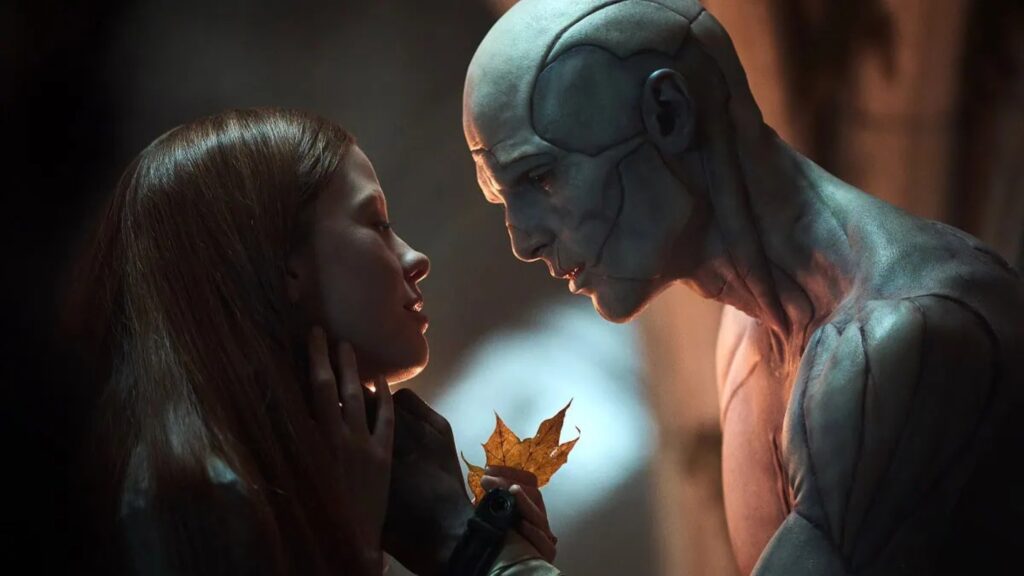Basic Info & Context.
“Frankenstein” is the 2025 Gothic-science-fiction re-imagining of Frankenstein; or, The Modern Prometheus by Mary Shelley, written and directed by Guillermo del Toro.
- Runtime: approximately 150 minutes.
- Budget: reported at about US$120 million.
- Release pattern: World premiere at the 82nd Venice International Film Festival on August 30, 2025. Following a limited theatrical release in the U.S. on October 17, and then a global digital release via Netflix on November 7, 2025.
- Box office (theatrical) to date: According to the Wikipedia page the gross is only US$313,641 (which suggests the theatrical run was extremely limited, or the data is incomplete).
So this is a big‐budget film, but distributed in a hybrid model (limited theaters + streaming). That context is important in assessing “box collection” and “success”.
Cast & Who Wears the Story.
Major Cast
Some of the major performers include:
- Oscar Isaac as Baron Victor Frankenstein (the scientist).
- Jacob Elordi as The Creature (Frankenstein’s creation).
- Mia Goth as Lady Elizabeth Harlander / Baroness Claire Frankenstein (multiple roles)
- Christoph Waltz as Henrich Harlander (a wealthy sponsor/arms dealer)
- Additional cast: Felix Kammerer as William Frankenstein (Victor’s younger brother) Lars Mikkelsen, David Bradley, Charles Dance, Ralph Ineson, Christian Convery among others.
Means Character (Narrative Anchor).
If we ask: “which character carries the story?” — the answer is primarily Victor Frankenstein (Oscar Isaac). The film is framed around his ambition, his obsession, his rise and fall, his relationship with his creation (The Creature). We follow his choices, his consequences, his guilt. Although the Creature (Jacob Elordi) becomes a focal point (and many critics highlight his performance) the moral and narrative weight rests with Victor as the “means character”: the viewpoint, the decision‐maker, the one whose journey we follow.
Box Office / Distribution & Performance.
- As noted, the budget is approx US$120 million.
- The publicly listed theatrical gross is surprisingly low: ~US$ 313,641 (per that same Wikipedia source) — but we should interpret with caution: limited release, streaming focus, overseas numbers not fully counted.
- Because of the Netflix model (theatrical → streaming) the “box collection” measure is less traditional; success may be judged by streaming views, awards recognition, brand impact rather than pure box-office.
- The release timing (limited theaters, then streaming) suggests the film is more of a prestige/“event” release than a wide blockbuster.
In short: commercially this is not going to look like a typical $120 m blockbuster that grosses $400–500 m+. Whether it “succeeds” will depend partly on digital metrics, awards, critical impact, legacy.
Niche, Tone & Thematic Domain.
Genre / Niche
This film falls into the niche of Gothic / gothic horror / science-fiction period epic. It’s a retelling of a classic monster myth, but filtered through Guillermo del Toro’s visual style, with large production values, gothic set pieces, monster mythos, philosophical themes. The “monster movie” genre, but elevated, adult, star-studded.
Tone & Themes
Key aspects to highlight:
- Creation & hubris: Victor’s ambition to “play God,” reanimate life, the dangers of unchecked scientific ambition.
- Isolation & otherness: The Creature’s plight, his status as outsider, his search for identity and belonging.
- Monstrosity & humanity: What makes a monster? The Creature’s moral arc, Frankenstein’s guilt, the parallel between creator and creation.
- Gothic aesthetics & horror with heart: Del Toro’s style suggests lush visuals, atmospheric terror, emotional weight above cheap scares.
- Legacy & adaptation: Re-imagining Mary Shelley’s novel for our time, wrestling with themes of trauma, body, science, responsibility.
So the niche is adult, gothic monster story; it is likely to appeal to fans of del Toro’s work, monster mythos, literary adaptation, and less to purely action-oriented audiences.

Deep Narrative Overview & Analysis.
Story Setup
The film introduces us to Baron Victor Frankenstein (Oscar Isaac), a brilliant scientist whose obsession with life, death and legacy drives him. His younger brother William (Felix Kammerer) plays a supporting role; their family, the Frankenstein lineage, is one of prestige and pressure. Victor’s fiancée Elizabeth (Mia Goth) and their social world (wealth, power, arms dealers) situate the story in a late-19th/early-20th-century aesthetic. The world is one where science and industry, ambition and capital, collide.
Victor’s experiments—borrowing from Shelley’s novel but re-imagined in del Toro’s vision—lead him to create a being from dead bodies, reanimated through electricity and Alchemical science. The Creature is played by Jacob Elordi, whose physical presence (scars, pale skin, long hair) is widely noted in early images.
Middle / Conflict
The bulk of the film revolves around the relationship between Victor and his creation. Victor’s ambition becomes guilt, his control becomes horror. Meanwhile, the Creature experiences awakening: confusion, rage, longing for connection, vengeance for his maker’s neglect. Del Toro uses gothic architecture, storm-lit experiments, decaying mansions, and vast laboratories to mirror internal chaos. Critics at Venice described the film as “visually stunning, full of passion, and Jacob Elordi steals the show.”
Elizabeth’s role and other family dynamics add emotional stakes: Victor’s ambition threatens personal relationships; the social world (Harlander, arms dealers, public reputation) threatens to overshadow the moral cost. The Creature’s violent rampage is not purely shock—it becomes commentary on what happens when a being is denied identity, denied compassion.
Climax & Resolution
Towards the film’s climax Victor must face the consequences of his creation’s revolt. The monster is no longer passive. Victor’s world collapses—social, scientific, familial. The Creature becomes a mirror of Victor’s ambition and failure. Without giving full plot spoilers: the ending resolves some arcs (Victor’s responsibility, the Creature’s destiny) but leaves others open (identity, legacy, what it means to be human). Critics noted the emotional weight of the finale even if some pacing issues emerge.
What Works
- The casting: Oscar Isaac and Jacob Elordi are praised for giving depth to their roles. Elordi in particular stands out as the creature; early reviews reference his performance as transcendent.
- Del Toro’s visual and thematic mastery: the film is described as richly gothic, emotionally resonant, and ambitious. For example Netflix’s Tudum described it as “a dark and sumptuous emotional drama — a character piece sprung from the pages of Shelley’s classic novel.”
- The blend of horror, science-fiction, period drama and monster myth makes the film layered: it is not just a scare-fest but a meditation on creation, responsibility and otherness.
- The fidelity and reinterpretation: The film appears to hew more closely to the book’s themes than many earlier adaptations, while still offering fresh visual and narrative ideas.
What Doesn’t Land / Potential Weaknesses
- The commercial model: Because of the limited theatrical release and subsequent streaming, the box office numbers are weak, which may affect public perception of success.
- Pacing and length: At ~150 minutes, some viewers and reviewers felt the film’s rhythm falters in the middle. The elaborate visual style sometimes comes at the cost of narrative clarity. Reddit commentary suggests “the end when del Toro cranks up the manufactured pathos to 11.”
- Audience expectation mismatch: Fans of monster-action or horror-thrillers may expect more thrills; this film is more operatic, more emotional, more gothic—so there is a risk of mis-marketing.
- Streaming model vs blockbuster budget: Despite the high budget, the film’s release model (limited ‘boutique’ theatrical + streaming) means its box-office cannot match typical studio tentpoles; thus measuring “success” is complex.
Why This Film Matters.
- Artistic ambition: When a major director (Del Toro) takes on a classic novel like Frankenstein, with a big budget and faith in streaming + theatrical hybrid, it signals that prestige cinema still exists in the monster/horror space.
- Cultural resonance: The themes of creation, otherness, identity are perennial, and in a time of AI, bioengineering, monster myth, the story is timely.
- Streaming era dynamics: The film showcases how big-budget films may pivot from theatrical dominance to hybrid distribution, which changes how we interpret “box collection” and success.
- Monster cinema lineage: Frankenstein is one of horror’s foundational texts. Del Toro’s version links the legacy of Karloff, Whale, Hammer horror etc, but attempts to bring fresh emotional depth.
Final Verdict.
Frankenstein (2025) is a richly crafted, ambitious adaptation that demonstrates what monster cinema can still achieve: deep emotions, lavish visuals, and moral complexity. It may not dominate the box office in the traditional sense (and its theatrical numbers so far are minimal), but as a piece of genre-art it stands out. If you enjoy films that blend horror with character-drama, period aesthetic with science-fiction idea work, and monster myth with human sorrow, this is one to watch.
For viewers expecting purely jump scares or fast-paced horror, they may find the film slower and more meditative than anticipated. But for those open to emotional crescendos, layered performance, and the ache behind the thunder of lightning-rods and stitched-body parts, Frankenstein delivers.





